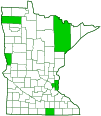small pirate wolf spider
(Piratula minuta)
Conservation • Description • Habitat • Biology • Distribution • Taxonomy
Conservation Status |
|
|||||||
| IUCN Red List | not listed |
|||||||
| NatureServe | NNR - Unranked |
|||||||
| Minnesota | not listed |
|||||||
Description |
||
Small pirate wolf spider is a small wolf spider. It occurs in the United States from Maine to North Carolina west to Minnesota and Illinois, and in Canada from Newfoundland west to Saskatchewan. It occurs throughout Minnesota. There are few records in the state, likely due to its small size and that it is frequently misidentified as one of seven other Piratula and Pirata species. Females are ⅛″ to 5⁄32″ (2.8 to 3.7 mm) in length and have a leg length of ⅜″ (10.1 mm). Males are smaller, 3⁄32″ to ⅛″ (2.5 to 3.2 mm) in length. The front part of the body (cephalothorax) is longer than wide. The upper side (carapace) of the cephalothorax is moderately low and relatively flat when viewed from the side, about the same height from the second (posterior) row of eyes to the dorsal groove. It is broadly rounded and nearly vertical in front, rounded and sloping on the sides. It is brown to blackish-brown with a pale stripe in the middle and a forked, reddish-yellow band that extends from behind the eyes on each side, merges near the distal groove, and extends to the rear margin. On each side of the carapace there is a submarginal pale stripe and a thin white marginal stripe. There are eight eyes in two rows of four. The front (anterior) row has four small eyes and is straight or slightly curved forward. The rear (posterior) row has two very large posterior median eyes (PME) and two large posterior lateral eyes (PLE). The PLE are set behind the PME, and some authors describe this arrangement as three rows of eyes. The rear row is about equal in width to the middle row. The PME are closer to the PLE than to each other. The PME and PLE have a layer of reflective tissue internally. This allows the spider to see in relative darkness. It also causes their eyes to shine when hit by the beam of a flashlight. The basal segment of the jaws (chelicerae) is large and powerful. The forward-facing (upper) margin has 3 teeth. The rear-facing (lower) margin has three teeth but the third is much reduced, making it appear to have just two teeth. The abdomen is egg-shaped and is covered with short hairs. It is dark brown with a row of five or six small white spots on each side. The legs are long and spiny. They are yellowish-brown and mottled with dark brown but are not banded. There are three claws at the end of the last segment (tarsus) on each leg, but these are not visible to the naked eye. |
||
Size |
||
Female Body Length: ⅛″ to 5⁄32″ (2.8 to 3.7 mm) Male Body Length: 3⁄32″ to ⅛″ (2.5 to 3.2 mm) Legspan: ⅜″ (10.1 mm) |
||
Web |
||
None |
||
Similar Species |
||
Habitat |
||
meadows, hayfields, marshes, swamps, and bogs. |
||
Biology |
||
Season |
||
May through September |
||
Behavior |
||
|
||
Life Cycle |
||
“Half-grown“ individuals overwinter and mature in late May and early June. |
||
Food |
||
|
||
Distribution |
||||
|
Sources Wallace, H. K. & Exline, H. (1978). Spiders of the genus Pirata in North America, Central America and the West Indies (Araneae: Lycosidae). Journal of Arachnology 5: 1-112. |
|||
| 6/8/2022 | ||||
Occurrence |
||||
|
||||
Taxonomy |
|||
| Class | Arachnida (Arachnids) | ||
Order |
Araneae (Spiders) | ||
Suborder |
Araneomorphae (Typical Spiders) | ||
| Infraorder | Entelegynae | ||
Zoosection |
RTA clade (RTA Clade Spiders) |
||
Zoosubsection |
Oval calamistrum clade |
||
Superfamily |
Lycosoidea (wolf spiders and allies) | ||
Family |
Lycosidae (wolf spiders) | ||
Subfamily |
Zoicinae | ||
Genus |
Piratula | ||
Until recently, this species was known as Pirata minutus. All spiders in the genus Piratula were formerly included in the genus Pirata. Piratula was treated as a synonym of Pirata. In a recent revision of the species Pirata (Omelko et al., 2011) Piratula was reestablished as a genus and 25 Pirata species were transferred to Piratula. |
|||
Synonyms |
|||
Pirata exigua Pirata minutus |
|||
Common Names |
|||
small pirate wolf spider |
|||
Glossary
Carapace
The hard, upper (dorsal), shell-like covering (exoskeleton) of the body or at least the thorax of many arthropods and of turtles and tortoises. On crustaceans, it covers the cephalothorax. On spiders, the top of the cephalothorax made from a series of fused sclerites.
Cephalothorax
The front part of the body of various arthropods, composed of the head region and the thoracic area fused together. Eyes, legs, and antennae are attached to this part.
Chelicerae
The pair of stout mouthparts, corresponding to jaws, in arachnids and other arthropods in the subphylum Chelicerata.
Tarsus
On insects, the last two to five subdivisions of the leg, attached to the tibia; the foot. On spiders, the last segment of the leg. Plural: tarsi.
Visitor Photos |
|||||
Share your photo of this arachnid. |
|||||
| This button not working for you? Simply email us at info@MinnesotaSeasons.com. Attach one or more photos and, if you like, a caption. |
|||||
Alfredo Colon |
|||||
 |
|||||
MinnesotaSeasons.com Photos |
|||||
|
|||||

Slideshows |
||

Visitor Videos |
|||
Share your video of this arachnid. |
|||
| This button not working for you? Simply email us at info@MinnesotaSeasons.com. Attach a video, a YouTube link, or a cloud storage link. |
|||
Other Videos |
|||

Created: 6/8/2022
Last Updated:


